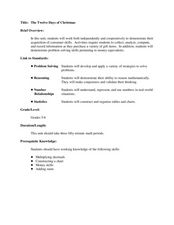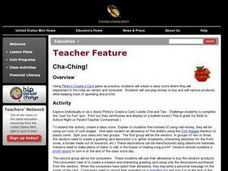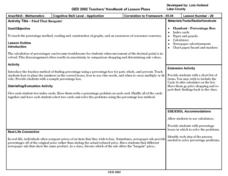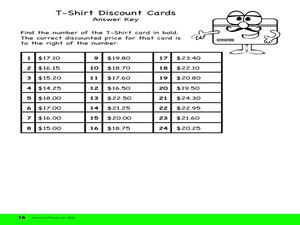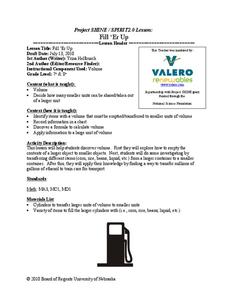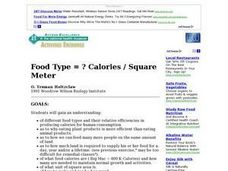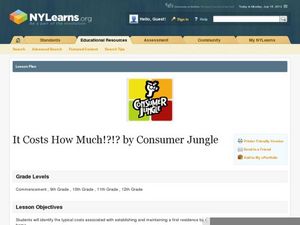Curated OER
The Twelve Days of Christmas
Students purchase gift items and practice collecting, analyzing, computing, and recording information. In this data lesson plan, students also complete money equivalent activities.
Curated OER
How are Things Lining Up
In this consumer math worksheet, students use the web to research and select a stock to buy. Students track and graph the stock’s activity over a two week period. The one page worksheet contains a blank graph and four questions. ...
Curated OER
New York City Delights: The Taxi Cab
You set the rate! Step into the shoes of a taxi driver in New York City, and also pretend to be a person who uses taxis to get around town. The class will conduct collaborative research to learn about the history of taxis. Then, they...
Baylor College
Do Plants Need Light?
Turn your classroom into a greenhouse with a lesson plan on plant growth. First, investigate the different parts of seeds, identifying the seed coat, cotyledon, and embryo. Then plant the seeds and watch them grow! Measure the new plants...
Curated OER
Cha-Ching!
Students play the Pinky's Create a Card game for practice. Students create a class store where they experiment in the roles as vendor and consumer. Students use play money to buy and sell various products, while keeping track of spending...
Curated OER
Statistics and Shopping
Students explore the concept of using consumer data and statistics to aid in the consumer decision making process. In this consumer data and statistics lesson, students research consumer data and statistics. Students analyze the data...
Curated OER
Transforming Food Energy: A Balancing Act
Students explain their role as consumers. They use a purchased calorimeter or make their own simple calorimeter to measure the energy content in selected foods. This interesting activity really gets students thinking about what they eat.
Curated OER
Find That Bargain!
Students explore the methods of calculating percentages, reading and the construction of graphs, and an awareness of consumer concerns in this lesson. The movement of the decimal point often results in uncertainty and confusion. This...
Curated OER
Wise Shoppers
Students complete several activities to learn about currency and the functions of money. In this money functions lesson, students complete activities to learn what are the functions of money. Students calculate item prices with...
Curated OER
KEEP ON TRUCKING
Students comprehend and apply concepts of data analysis and distributions by observing modes of transportation for food and fiber products. They are given an activity sheet "On the Lookout for Agriculture." Students discuss the discuss...
Curated OER
Meet Kit: An American Girl
Students explore economics by participating in a role-play activity. In this consumerism instructional activity, students identify the Great Depression, the cause of the financial collapse and the devastation it caused people their own...
Curated OER
Pizza Portions
Students explore mathematics by participating in a pizza pie activity. In this nutrition instructional activity, students identify the caloric intake in a piece of pizza and estimate the average number of slices eaten by a person....
Curated OER
Getting it Right!
Students investigate error. As shown in earlier activities from navigation lessons 1 through 3, without an understanding of how errors can affect position, one cannot navigate well. Students explore how computers can help in navigation....
Curated OER
Recycling
Students investigate how to reduce, recycle, and reuse items in order to conserve natural resources. They complete a trash graphing activity after discussing different types of trash. Finally, the examine ways to buy recycled products to...
Curated OER
Junk Mail Overload!
Learners discuss the "junk mail nuisance" with the teacher and share their opinions on the problem. Students collect a week's worth of junk mail, bring to class and complete a chart about the amount and weight. Learners then complete an...
Curated OER
Opening your first bank account
High schoolers investigate opening a bank account. In this secondary Consumer Mathematics activity, students read A Guide to Your First Bank Account and take a short quiz on the information.
Curated OER
Fill 'Er Up
Students identify how many smaller units can be found in a later unit. In this geometry lesson, students calculate the volume and the transfer amount to a smaller unit. They solve real life problems using the formula for volume.
Baylor College
About Air
Give your class a colorful and tasty representation of the components of the mixture that we call air. Pop a few batches of popcorn in four different colors, one to represent each gas: nitrogen, oxygen, argon, and carbon dioxide. The...
Curated OER
Food Type And Calories Per Square Meter
Students compare the efficiency of producing food calories in different types of food then calculate how much land is required to supply their food for a year. They then graph the results.
Curated OER
Lesson Plan: The Car Chase Scence
Students investigate how to be informed when buying a car. In this research skills lesson, students use the Federal Citizen Information Center Website to find information they need to complete an activity featuring all of the costs of...
Curated OER
What is the Best Chip?
Scholars collect data about chips. They pick their favorite type of chip from a given variety such as potato chips, tortilla, or banana chips. Then they write on an index card their favorite chip and why it's their favorite. They also...
Curated OER
Take It To the Bank
Examine how the economics of a school store relate to real world economics. Elementary students explore various websites, complete a Venn diagram, create a schedule of wages for the students, read the book "A Chair For My Mother" and...
PLS 3rd Learning
It Costs How Much!?!?
Many teens conjure up images of how great their first apartment will be, but they lack a solid understanding of what it will cost to make it look that way. To gain an appreciation for the cost of furnishings, they create a collage of a...
Curated OER
Nutrition Lesson Plan
Second graders complete a survey as class answering the question: "Did you eat breakfast this morning?". They place a tally mark in the column that best represents their answer. They then discuss the results in the graph.


